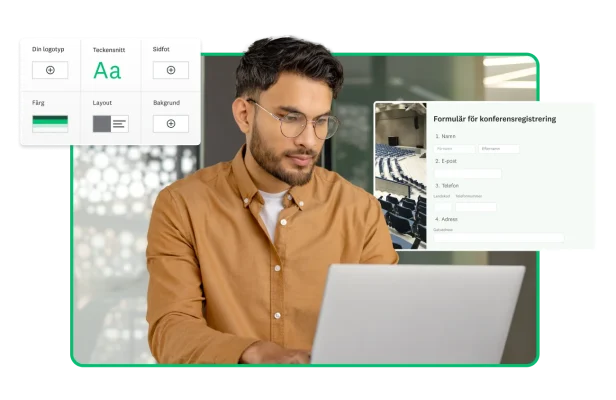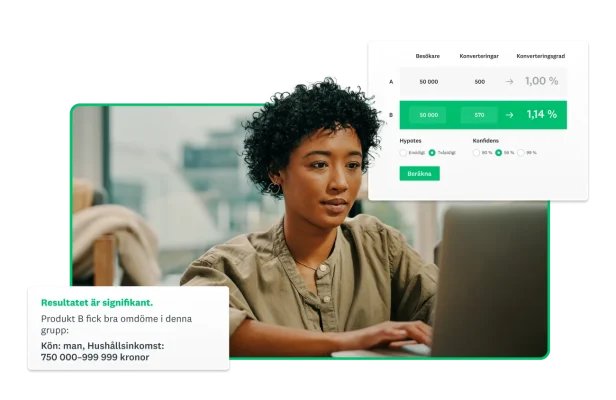Ta reda på bästa praxis för enkäter och formulär
Få ut mesta möjliga av enkäter och formulär med resurser och artiklar från SurveyMonkey-teamet.






Utforska våra resurser
Utvalda artiklar

Beräkna Net Promoter® Score exakt och få tips som kan förbättra det.

Mår personalen bra? Ta reda på hur du kan formulera effektiva enkätfrågor för att få svar på det.

Upptäck ett smidigt sätt att koordinera mötestider som fungerar för hela teamet.

Hur många svarande behöver du till enkäten? Använd vårt verktyg för beräkning av provgruppsstorlek för att få bästa resultat.
Bästa praxis för enkäter

Bästa praxis och riktlinjer för hur man skapar enkäter
Designa enkäter, samla in svar och analysera informationen som ett proffs.
Ta reda på hur du skapar enkäter, samlar in svar och analyserar data som underlag för bättre affärsbeslut.
Få feedback direkt när du undersöker åsikter och fatta beslut baserat på data du får i realtid.
Läs mer om de vanligaste typerna av snedvridning i enkäter och hur du kan undvika dem i din undersökning.
Läs om ett av de mest pålitliga sätten att mäta åsikter, uppfattningar och beteenden på – och hur du kan använda det i nästa enkät.
Utforska vanligt förekommande enkätfrågor och ta reda på hur du kan ta fram effektiva enkäter som ger bästa möjliga resultat.
Kundfeedback

Så här bygger du upp lyckade program för kundfeedback
Lär dig bästa praxis för att samla in och använda feedback till att förbättra produkter, tjänster och kundrelationer.
Ta reda på hur du kan använda kundinsatspoäng för att minska friktionen och öka lojaliteten.
Lär dig beräkna NPS och skapa enkäter för att mäta kundupplevelse och kundnöjdhet.
Utforska fördelar och begränsningar med NPS och varför det används så mycket till att mäta kundlojalitet och förutspå tillväxt.
Lär dig skriva bättre enkätfrågor om kundnöjdhet så att du får insikter du har nytta av.
Genom att mäta de fem dimensionerna av servicekvalitet kan du hitta nya sätt att göra kunderna nöjda och förbättra deras upplevelser.
Marknadsundersökningar

Marknadsundersökningar: vad är de, varför är de viktiga, och sätt att komma igång på
Läs om den här strategin där insamlade data är basen som ger insikter i vad konsumenter tycker, om deras attityder och även om marknaden sett ur ett bredare perspektiv.
Lär dig hur du snabbt kan skapa intressanta marknadsundersökningar på bara några minuter.
Läs om hur sekundära undersökningar skiljer sig från primära undersökningar och varför de bör användas i verksamheten.
Få informationen du behöver för att fatta bättre beslut om dina produkter och tjänster.
Är resultatet statistiskt signifikant? Använd den här beräkningsfunktionen för att få ännu mer pålitliga resultat.
Personalfeedback

Feedback från medarbetare: tips, exempel och mallar
Lär dig ställa rätt frågor, bygg upp ett stabilt program för personalfeedback och använd resultaten för att öka andelen som vill jobba kvar.
Ta reda på vilka frågor du ska ställa för att förbättra rekryteringsprocessen och locka till er de bästa kandidaterna.
Utforska fördelarna med att använda medarbetarundersökningar för att öka engagemanget, identifiera arbetsplatsproblem och förbättra kulturen i organisationen.
Stötta medarbetarna med utbildningsenkäter för att utvärdera hur effektiva utbildningsprogrammen är och identifiera områden som behöver förbättras.
Lär dig strategier för att främja en hälsosam arbetskultur genom tydlig kommunikation, erkännande och inkludering.
Få enkätmallar och expertvägledning som hjälper din organisation att skapa en mer inkluderande kultur.
Formulär

Skapa webbformulär
Skapa webbformulär enkelt med SurveyMonkey och börja samla in svar direkt.
Få vägledning om hur du kan utforma effektiva webbformulär, inklusive bästa praxis för struktur, frågetyper och användarupplevelser.
Skapa registreringsformulär online som är lätta att anpassa och fylla i. Välj den mall som passar dig i vårt stora utbud.
Samla in feedback direkt från kunder och andra för att stärka ditt företag, din produkt eller ditt varumärke.
Få tips om hur du skapar OSA-formulär och lär dig samla in och registrera svar från gästerna för att effektivt hantera deltagarantalet på evenemanget.
Öka svarsfrekvensen, samla in kontaktuppgifter och effektivisera registreringar och ansökningar med inbäddningsbara formulär.
Undersökning och analys

Så här analyserar du enkätdata: metoder och exempel
Ta reda på hur du kan analysera enkätdata effektivt och enklare skapa bättre enkäter.
Med rätt information och verktyg kan du använda statistiska metoder för att analysera dina enkätdata utan att vara expert.
Få djupgående insikter i undersökande forskning och lär dig fyra olika sätt att implementera den i ditt undersökningsarbete.
Förstå samband mellan orsak och verkan och fatta välgrundade beslut genom att testa hypoteser och undersöka resultat.
Läs våra tips om hur du använder kvantitativa undersökningar för att få ut mer av företagets enkäter.
Lär dig hitta felmarginalen och använd vår onlinekalkylator för att mäta den.
Produktutveckling

Så här tar ni fram bättre produkter snabbare med feedback så gott som i realtid
Lär dig använda enkäter under hela produktutvecklingsprocessen för att samla in kundfeedback, identifiera behov och styra produktförbättringar.
Lär dig hur idérankning kan hjälpa dig att skapa vinnande produkter som har stöd av research och analyser.
Utvärdera kundernas betalningsvilja, få insikter i prisstrategier och efterfrågan.
Samla in insikter före och efter lanseringen för att öka produkt- och kundnöjdheten.
Få dina produktkoncept och -idéer bekräftade av en tillförlitlig målgrupp – på mindre än en timme.
Ta reda på hur du kan planera, utforma, skicka och analysera en koncepttestningsenkät för att förbättra nästa annonskampanj eller produktlansering med mera.
Evenemangshantering

Hantering av evenemangsfeedback: Enkäter före och efter evenemanget
Få tips och mallar som gör nästa evenemang till en succé från början till slut.
Ta reda på vilka frågor du ska ställa i evenemangsenkäter för att samla in värdefull feedback i alla stadier av evenemanget.
Få färdiga enkätmallar som är skräddarsydda för evenemangsplanering, så att det blir enklare att samla in gästers preferenser och förväntningar.
Anordna bättre evenemang genom att samla in feedback från deltagarna med enkäter.
Experttips på hur du kan samla in användbara insikter för att förbättra nästa fest eller företagsevenemang.
Var välförberedd, välorganiserad och använd SurveyMonkey-verktyg så att dina evenemang löper på smidigt.
Marknadsföring

Marknadsföringsenkäter: exempel på frågor och mycket annat
Skapa en marknadsföringsenkät på bara några minuter och få informationen du behöver för att förbättra saker som kundnöjdhet, produkter, priser, mediekampanjer och mer.
Få information om marknaden för smarta och strategiska affärsbeslut.
Lär dig de bästa tillvägagångssätten för att utföra annonstest – från att idéstorma om frågor till att analysera resultat – så att du kan hitta det bästa alternativet.
Följ resultatet för ditt varumärke över tid och se hur det utvecklas.
Lär dig hur du får intressanta data till innehållsmarknadsföring med egna undersökningar.
Upptäck hur branschproffs använder AI i marknadsföringen och fördjupa dig i SurveyMonkeys undersökningsstatistik om AI-användning.
Utbildningsenkäter

Utbildningsenkäter för skolor, lärare och elever
Vi samarbetade med det amerikanska utbildningsdepartementet och Harvard Graduate School of Education för att skapa enkätmallar som kan bidra till förbättrade utbildningar.
Skicka utbildningsenkäter till elever, lärare och föräldrar för att ta reda på hur det går för din skola eller ditt universitet – bland mycket annat.
Förstå elevernas behov, preferenser och utmaningar så att du kan skapa en mer stöttande utbildningsmiljö.
Förvandla din undervisning med frågor till elevenkäter. Få ärlig feedback på lektioner, aktiviteter med mera för bättre inlärning.
Använd enkätmallen från SurveyMonkey och Harvard Graduate School of Education K-12 för att förbättra föräldraengagemanget.
Ge din forskning djup med data och insikter från enkäter.
Hälsovårdsenkäter

Hälsovårdsenkäter: frågor och mallar
Använd vårdenkäter för att samla in patientfeedback, förbättra vårdkvaliteten och stötta beslutsfattande på vårdinrättningar.
Använd enkäter om patientnöjdhet för att utvärdera vårdupplevelser och förbättra vården av patienter.
Använd den här enkätmallen för att utvärdera och förbättra patientsäkerhetskulturen inom din hälso- och sjukvårdsorganisation.
Lär dig använda enkäter för att samla in data som är viktiga för kliniska studier, patientresultat och vårdutveckling.
Läs hur SurveyMonkey hjälper kunder med krav på HIPAA-efterlevnad.
Få exempel på frågor om utvärderingar, exempel på frågeformulär gällande hälsovård och lär dig att skriva enkätfrågor avseende hälsovård som ett proffs.
Frågetävlingar

Skapa effektiva frågetävlingar med de här tipsen om frågeutformning, formatering och användning av frågetävlingar för engagemang och bedömning.
Enkäter för ideella organisationer

Med webbenkäter kan du få värdefull feedback från givare, volontärer och de som jobbar med insamlingarna.
Net Promoter, Net Promoter Score och NPS är varumärken som tillhör Satmetrix Systems, Inc., Bain & Company, Inc. och Fred Reichheld.